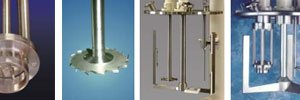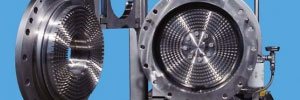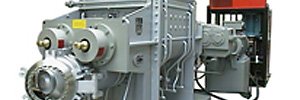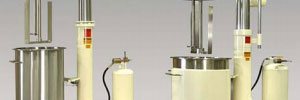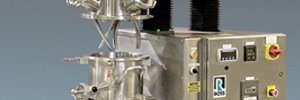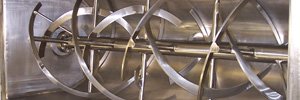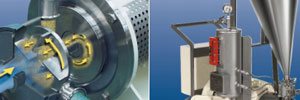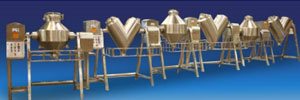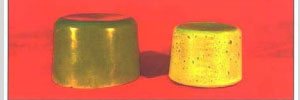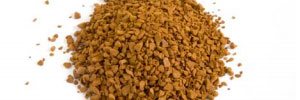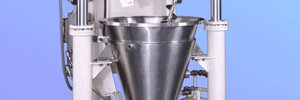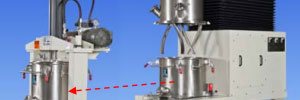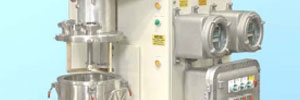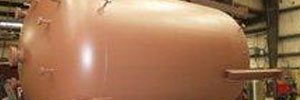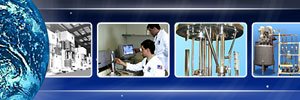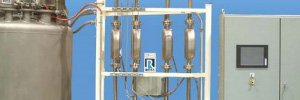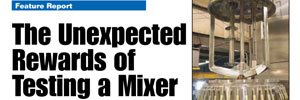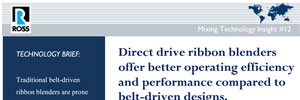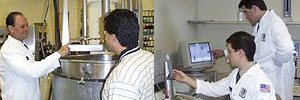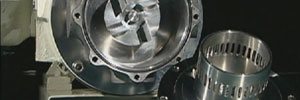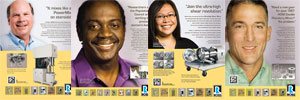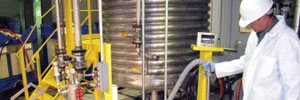Adhesives and Sealants
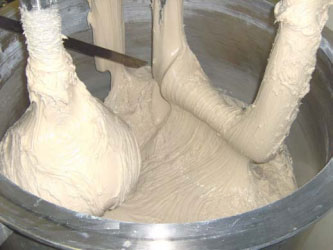
ROSS mixers, blenders and dispersers are used throughout the adhesives and sealants manufacturing industry. Applications include the simple stirring of low viscosity miscible fluids to the sophisticated dispersion of high viscosity dissimilar materials.
The preparation of almost all adhesives begins and ends with adequate mixing. From the homogenization of adhesive emulsions, to the dissolution of polymers into solvents, or mastication of rubber and let-down of master batches, the type of mixing equipment and method hugely dictate over-all processing efficiency and end-product quality. ROSS uses effective and updated mixing technologies being implemented across many of today's competitive adhesives manufacturing plants, as well as new equipment designs increasingly being recognized by the industry as potential solutions to prevailing mixing challenges.
- Epoxies - multi component reactive mixtures used in the electronics, medical, marine, adhesive/sealant, semiconductor and fiber optics industries. ROSS mixers are used to add fillers, viscosity reducers, colorants, thickeners, accelerators, adhesion promoters, etc.
- Hot Melts - this thermoplastic adhesive is commonly sold in solid sticks designed to melt in special application tools. Our mixers are used for low and high viscosity materials and are often supplied to extrude the hot melt into a final form.
- Latex Sealants - typically used for filling holes in wood, as a firestopping material, padding of electrical outlet boxes, glass glazing etc. Ultra high viscosity mixtures under vacuum operating conditions are possible using ROSS mixers and controlled shear rates.
- UV & Light Activated Adhesives - UV & light cured - activated adhesives for bonding, sealing and coating applications are produced on ROSS mixers and used for automotive, medical, dental and general industrial applications.
- Pipe Joint Compounds - used for sealing metal or plastic pipe joints and fittings. These compounds can be either low viscosity solutions of plastic or high viscosity non-flowing materials.
- Polybutene Emulsions - applications for these emulsions are wide ranging and include lubricants, sealants and adhesives, coatings, polymer modification, personal care products and more. Because of the big range of applications a wide variety of variable shear mixers and dispersers are used for this application.
- Polyurethanes - polyurethane formulations cover a wide range of stiffness, hardness, and densities. These materials include flexible foam , rigid foam used for thermal insulation, soft solid elastomers used for gel pads and print rollers, and hard solid plastics used as electronic instrument bezels and structural parts. ROSS mixers offer a versatility including vacuum, jacketing for temperature control and multiple speeds when manufacturing these end products.
- Rubber Cements and Adhesives - rubber cements are commonly used for applications to easily peel or rub off without damaging the substrate or leaving any trace of adhesive behind. They are ideal for use with photographs and specialty papers and as cements to secure laminates. ROSS mixers easily dissolve at high speed the polymers used in the carrier solvent.
- Silicones - silicones are used for a variety of applications and in a very diversified industrial mix. The product consistencies are broad thus many different mixers and blenders are used in the manufacturing process. Common end products include sealants, gasketing compounds, mold making materials, electronic encapsulants, breast implants and personal care products.
- Recommended Mixing Equipment for Wood Putties and Fillers
Wood putties and fillers are compounds used to hide woodworking imperfections such as holes, scratches and gouges. - Recommended Mixing Equipment for Emulsion Adhesives
Water-based emulsion adhesives serve multi-purpose uses in packaging, construction, textile and other applications. They bond plastic, coated papers, wood, metal surfaces, ceramics, concrete, glass and other substrates. - Recommended Mixing Equipment for Structural Adhesives
Structural adhesives are formulated from different chemistries depending on their end use and desired performance. Base resins are typically epoxy, acrylic, polyurethane or cyanoacrylate. - Recommended Mixing Equipment for Silicone Elastomers
Silicone elastomers are highly versatile materials used in making various end products, from automotive gaskets and power cables to sanitary tubings and medical implants. Also commonly called silicone rubber, this type of elastomer consists of crosslinked silicone polymers typically filled with additives to achieve desired physical and chemical properties. - Recommended Mixing Equipment for Urethane Sealants
Urethane sealants are applied in a wide variety of substrates. Different chemistries give rise to specific cure rates, bond strength, flexibility, hardness, chemical and heat resistance, vibration and sound absorption, consistency and other properties that affect sealing performance. - Recommended Mixing Equipment for Pressure Sensitive Adhesives
Formulated from rubber, acrylic or silicone polymers, pressure-sensitive adhesives are produced in several different ways depending on their chemistry, end-use and application. - Recommended Mixing Equipment for Medical Adhesives
The growing demand for prescription and over-the-counter transdermal products encompasses a wide range of uses and conditions, from motion sickness and smoking cessation, to hormone replacements and pain management. - Recommended Mixing Equipment for Encapsulation Materials
The majority of encapsulation materials utilized in electronic packages are highly-filled epoxy and hardener resin systems. - Multi-purpose laboratory mixers
Multi-Shaft Mixers are highly efficient and versatile equipment ideal for developing formulations of wide ranging viscosities and characteristics. - 5 ways to reduce labor costs in your mixing operation
Labor costs account for a significant portion of mixing costs. This bulletin presents five basic tips for optimizing labor costs and improving productivity in the mixing operation. - Multi-viscosity mixing in a
Triple-Shaft Mixer
This bulletin provides a step-by-step look at a typical multi-shaft mixer application which demonstrates the system’s processing flexibility in terms of mixing, heating, cooling and deaerating batch material at different viscosity stages. - Processing techniques for
multi-agitator systems
This bulletin discusses some processing techniques for mixing in a multi-agitator system. - Buying reconditioned mixing
equipment
When properly restored to perfect working condition, ideally by the OEM, a reconditioned mixer or blender is comparable, if not equal, in efficiency to new equipment. The savings in cost and faster shipment help you get to the profitable stage sooner without sacrificing reliability. - One pot mixing
Multi-step mixing operations involving two or more pieces of equipment can be labor-intensive and time-consuming. With the use of a versatile mixing system, some of these applications can be batched and completed in a single vessel. This one-pot processing approach can significantly reduce cycle times, simplify clean-up and maintenance, enhance batch-to-batch consistency and improve overall production efficiency.. - Mixing highly filled compounds
Obtaining a good dispersion of fillers into a mixture is critical to end product quality. Highly filled, viscous compounds can be successfully prepared in multi-shaft or planetary mixers. - Advantages of double planetary
mixers over sigma blade kneaders
Many high viscosity materials that are being made on sigma blade kneaders can be processed in double planetary mixers. The advantages of switching to the double planetary mixer design include better cleanability, smaller footprint and lower capital cost. - Preparing for a mixing trial.
Simulation trials are useful experiments that help identify the right mixer for a specific application and predict machine performance. This bulletin discusses some preparation ideas for a smooth and productive mixer testing. - Mixing dilatant materials
Dilatant materials pose a unique mixing challenge due to their very nature: the greater the shear forces applied to the material, the more resistance is encountered. Heavy-duty, high-torque double planetary mixers operated under comparatively low speeds are ideal for processing shear-thickening mixtures. - Mixing high solids
formulations
Mixer selection for high solids formulations depends on viscosity rather than percent solids. Regardless of solids concentration, low-viscosity mixtures can be prepared in single-shaft rotor/stator mixers or high speed dispersers. For products that undergo a high viscosity phase, multi-agitator and planetary mixing equipment are commonly employed. - Shorten your dissolution time by switching to a multi-agitator mixer.
Dissolution processes can be optimized through the use of multi-agitator mixers which provide a combination of low-speed blending, high shear mixing, particle size reduction and superior heat transfer. - Hybrid planetary mixers
produce high viscosity mixtures with ultra-fine dispersion quality.
Hybrid planetary mixers are utilized for creating fine dispersions in viscous mixtures, typically within the viscosity range of 100,000 to 2 million cP. Intense mixing is applied to the product by constantly advancing a high speed disperser and a low speed stirrer into the batch. Solids are quickly incorporated into the viscous bulk material and agglomerates are dispersed regardless of product flow characteristics. Designs for multiple planetary stirrers and disperser blades are available for more demanding applications. - High speed mixing: saw-tooth dispersers vs. rotor/stator mixers
The saw-tooth disperser and rotor/stator mixer are two of the most widely used high speed mixers yet many are unaware of the differences in their utility and operating capacities. Knowing the unique attributes of these devices is important in mixer selection and process optimization. - Consider the advantages and disadvantages of scrapers.
Consider the advantages and disadvantages of scrapers.
The use of scrapers in batch mixing operations helps improve product homogeneity and heat transfer efficiency. However, there are cases wherein scrapers are not recommended such as in the processing of abrasive applications or highly viscous, sticky materials. - Multi-agitator mixer/reactors
Multi-agitator mixers are ideal for reaction processes that require intense mixing, high speed dissolution, emulsification, deagglomeration or heating/cooling of viscous liquids. - Double planetary mixers are ideal for low shear dispersion of viscous materials.
Viscous products possessing shear-sensitive behavior, fragile components or abrasive properties require gentle but thorough mixing. In most cases, a double planetary mixer is the best choice for processing such applications. - Helical double planetary blades promote better and cleaner mixing
Traditional double planetary mixers equipped with rectangular-shaped paddles are prone to ‘climbing’ issues where product tends to ride up the blades and out of the mix vessel. Precisely angled helical planetary blades overcome this problem and promote better, cleaner mixing.

